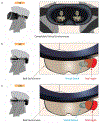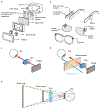Extended reality for biomedicine
- PMID: 37051227
- PMCID: PMC10088349
- DOI: 10.1038/s43586-023-00208-z
Extended reality for biomedicine
Abstract
Extended reality (XR) refers to an umbrella of methods that allows users to be immersed in a three-dimensional (3D) or a 4D (spatial + temporal) virtual environment to different extents, including virtual reality (VR), augmented reality (AR), and mixed reality (MR). While VR allows a user to be fully immersed in a virtual environment, AR and MR overlay virtual objects over the real physical world. The immersion and interaction of XR provide unparalleled opportunities to extend our world beyond conventional lifestyles. While XR has extensive applications in fields such as entertainment and education, its numerous applications in biomedicine create transformative opportunities in both fundamental research and healthcare. This Primer outlines XR technology from instrumentation to software computation methods, delineating the biomedical applications that have been advanced by state-of-the-art techniques. We further describe the technical advances overcoming current limitations in XR and its applications, providing an entry point for professionals and trainees to thrive in this emerging field.
Conflict of interest statement
Competing interests J.W. and F.S. are employees of Shanghai United Imaging Intelligence Co., Ltd., and the company has no role in designing and performing the surveillance and analyzing and interpreting the results. The other authors declare no competing interests.
Figures




References
-
- Blanc T, El Beheiry M, Caporal C, Masson J-B & Hajj B Genuage: visualize and analyze multidimensional single-molecule point cloud data in virtual reality. Nat. Methods 17, 1100–1102 (2020). - PubMed
-
- Safaryan K & Mehta MR Enhanced hippocampal theta rhythmicity and emergence of eta oscillation in virtual reality. Nat. Neurosci 24, 1065–1070 (2021). - PubMed
-
- Canning CG et al. Virtual reality in research and rehabilitation of gait and balance in Parkinson disease. Nat. Rev. Neurol 16, 409–425 (2020). - PubMed
Grants and funding
LinkOut - more resources
Full Text Sources
Research Materials
